Regular readers of Geeky Hobbies will probably already know that the original Ticket to Ride is my favorite board game of all time. That is saying a lot as I have played around 800 different board games. The original game is so elegant as it finds the perfect mix between being accessible while still having enough strategy to keep people interested. The game is close to perfect where I am always up for a game. Due to its success it has lead to quite a few different spinoffs over the years which mostly involve different maps and slightly tweaked rules like Ticket to Ride Europe and Ticket to Ride Marklin. Today I am looking at Ticket to Ride First Journey which is basically the simplified version of the game that is meant for younger children. I had some mixed feelings headed into the game as I was skeptical whether Ticket to Ride really needed to be simplified as the original game was quite simple in its own right. Ticket to Ride First Journey is a great game for families with younger children, but it doesn’t reach the levels of the original game due to the reliance on luck.
How to Play Ticket to Ride First Journey
Setup
- Place the gameboard in the middle of the table.
- Each player chooses a color and takes 20 trains of the corresponding color.
- Shuffle the train cards and deal four cards to each player. The rest of the train cards will be placed facedown to form the train deck.
- Shuffle the ticket cards and deal two cards to each player. Players should keep these cards hidden from the other players. Place the rest of the ticket cards face down on the table to form the ticket deck.
- Place the four coast-to-coast bonus ticket cards next to the gameboard.
- The youngest player will start the game.
Playing the Game
On a player’s turn they will be able to take one of three actions:
- Draw two train cards from the train deck.
- Claim a route.
- Draw new ticket cards.
After a player has taken one of these actions play will pass to the next player clockwise.
Claiming A Route
If a player wants to claim a route they will have to play cards from their hand that match the color of the route. They have to play one card for each space of the route. Locomotive cards (multi-color cards) can be played as any color. The cards that are played are added to the discard pile. After claiming the route the player will place their color trains on the spaces to mark that they control that route.
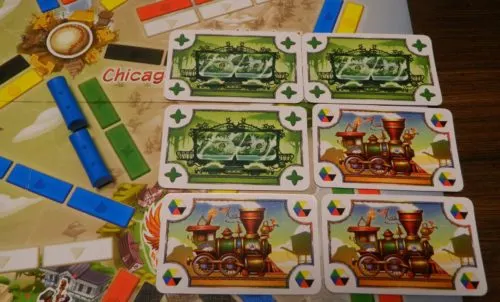
The blue player wants to claim the route between Chicago and Atlanta. The route consists of two green spaces. To claim the route the player will have to play two green train cards, one green and one wild train card, or two wild train cards.
A couple rules must be followed while claiming routes:
- You can claim any unclaimed route even if it doesn’t connect to any of your other routes.
- You may only claim one route each turn.
- If there is a double route between two cities a player can only claim one of the two routes.
Completing A Ticket
Throughout the game players are trying to connect the cities on their ticket cards. When a player completes a continuous line between the two cities listed on one of their ticket cards they will tell the other players and flip over the card. They will then draw a new ticket card to replace the card that they completed.
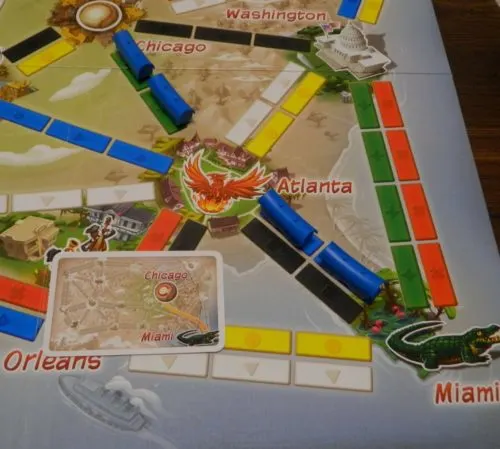
The blue player has a ticket to connect Chicago to Miami. As they have connected the two cities they have completed the ticket.
If a player completes a continuous route from one of the east coast cities (New York, Washington, Miami) to one of the west coast cities (Seattle, San Francisco, Los Angeles) the player has completed a coast-to-coast route. They will claim one of the coast-to-coast bonus cards which will count as a completed ticket at the end of the game. Each player can only claim one of these cards.
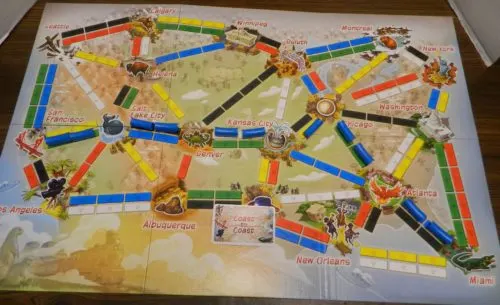
The blue player has successfully created a path of routes that connect Miami to San Francisco. Since they have completed a coast to coast set of routes they will take a coast to coast card.
Draw New Ticket Cards
If a player doesn’t think they will be able to complete the tickets in their hand, they may use their turn to draw new ticket cards. The player will discard the two ticket cards from their hand and draw two new cards.

This player didn’t like their current tickets/couldn’t complete them. They decided to discard their old tickets to draw two new tickets. One of the new tickets has the player connecting Calgary to Chicago. The other ticket requires the player to connect Calgary and Los Angeles.
End of Game
Ticket to Ride First Journey can end in one of two ways.
If a player completes their sixth ticket card they will automatically win the game. They will take the golden ticket to celebrate their victory.
If a player places their last train onto the gameboard the game will end immediately. Each player counts up how many ticket cards that they have completed. The player who has completed the most tickets wins the game. If there is a tie for the most ticket cards completed all of the tied players will win the game.
My Thoughts on Ticket to Ride First Journey
As most people are probably already familiar with Ticket to Ride I am not going to waste a lot of time going over my thoughts of the original game. Ticket to Ride is arguably my favorite board game of all time because it does a fantastic job balancing between accessibility and strategy. The game may be a little more difficult than your typical mainstream game, but you can generally teach the game to new players within ten or so minutes. The game is so accessible because the actions that you can perform are quite straightforward and are easy to understand. This makes the game work quite well with younger children as they should be able to understand what they are supposed to do. While the actions might be pretty simple they give players plenty of options. The game relies on some luck, but it mostly depends on what cards you take and how you use them to complete tickets and score points. The player with the best strategy will likely win the game.
In recent years there has been a drive towards creating kids versions of classic designer board games. Some of these make sense as they take more complicated games and boil them down to the main mechanics to be easily digested by younger children. I was curious about what Ticket to Ride First Journey would do though as the original game was pretty simple in its own right. Honestly most children around the age of eight or so shouldn’t really have any troubles with the original game. I was wondering how the main gameplay would be altered in order to appeal to even younger children. The game accomplishes simplifying the original game in a couple different ways:
- The game eliminates the traditional scoring entirely. Instead players are competing to complete six different tickets.
- In the original game you couldn’t get rid of tickets you chose to keep even if you couldn’t finish them. This was because uncompleted tickets would count as negative points. In Ticket to Ride First Journey you can use a turn to discard your uncompleted ticket cards and replace them with new cards.
- The gameboard is simplified. There are less stations and you need less cards to acquire each route.
- There is no longer a set of face up train cards that you can pick from. Instead players draw cards from the top of the pile.
- Ticket to Ride First Journey includes a coast-to-coast bonus card if you are able to connect a city from the east coast to the west coast. This is basically a more simplified version of the longest route mechanic from the original game.
- The game features less trains than the original game which means it takes less time to complete.
Those are basically the only differences between Ticket to Ride First Journey and the original game. In the goal to make the original game easier to play I think it does a good job. The original game was easy to play and yet First Journey is even easier. The game has a recommended age of 6+ and I think that is probably pretty accurate as most six year olds should be able to play the game without any issues. I could even see some kids that are slightly younger being able to play the game. Basically the game only requires children to recognize colors, have basic counting skills, and be able to spot the cities on their tickets and create a path between them. For parents that are sick of playing games like Candyland I think Ticket to Ride First Journey would be a great alternative. The game is not as engaging as the original, but it is a considerably better option than most games made for younger children. If you are looking for a good game to play with younger children I think Ticket to Ride First Journey would be a great choice.
Ticket to Ride First Journey also seems to play quite a bit quicker than the original game. I would say that most games of Ticket to Ride First Journey should take around 20-30 minutes while the original game usually takes around 45 minutes to an hour. This is a good thing as it will keep younger children’s attention where they won’t become bored halfway through the game. This could also make it a good filler game for people that don’t have the time for a full game of Ticket to Ride. I would think most people would just prefer to play the original game, but people who are looking for a shorter game may be interested in Ticket to Ride First Journey.
Ticket to Ride First Journey is a good/great game, but its biggest fault is that is is clearly inferior to the original game. You can have fun with the game as it is a good game. Unless you have young children though there is no real reason to play it over one of the other versions of the game. Even if you have children the potential audience is kind of limited as the original game is simple enough that you can play it with most children around age eight or so. Therefore the sweetspot for Ticket to Ride First Journey is basically around ages five to eight. Children younger than that will probably not understand the game while kids older than that will probably prefer the original game as it is simple enough and clearly better.
The main reason why the original is better than Ticket to Ride First Journey is due to the reliance on luck. The original game relied on some luck but the First Journey relies on considerably more. Most of the luck comes from the cards that you end up drawing. I honestly don’t know why the game decided to get rid of the face up train cards as this adds a lot more luck to the game than you would expect. In the original game you would have some choice over what train cards that you could take on your turn. If one of the cards you needed was face up you could just take it and complete the set you needed to claim a route. If you didn’t like any of the cards you otherwise could take face down cards. This choice is eliminated from Ticket to Ride First Journey though as you can only draw from the face down pile. You better hope you get lucky and draw the color cards you need or you will have a hard time claiming the routes you need. The game somewhat offsets this by adding more wild cards to the game. This doesn’t offset the amount of luck that was added due to the elimination of face up cards though. If you aren’t lucky when you draw train cards you are going to have a hard time winning the game.
Luck also comes from the ticket cards. Like the original game your fate is going to really depend on what ticket cards you end up drawing. Unlike the original game though there are no other ways of scoring points outside of completing tickets. So players who don’t get good tickets can’t find another way to win the game. The good news is that unlike the original game you don’t get penalized from failing to complete tickets, and you can easily discard them for new ticket cards. Pretty much all of the tickets in the game only require 1-3 routes to complete them. This usually equates to four to six train cards. Basically the key to winning in Ticket to Ride First Journey is to get ticket cards with cities that are near one another. A player that can get ticket cards that can utilize routes that the player has already acquired will have a much better chance of winning the game. You could end up drawing cards at the end of the game that you have already completed as you have already connected the two cities. As the game only relies on completing tickets there is no way to offset the luck from the ticket cards by claiming longer routes or having the longest overall route. The player who gets the most ticket cards that work together will probably win the game.
As Ticket to Ride First Journey is the children’s version of the original game I assumed that it would be less cutthroat than the original game. In some ways it seems less cutthroat and in other ways it seems more cutthroat. Ticket to Ride First Journey uses a lot of routes that only require one or two train cards in order to complete. This makes the game easier to play, but it also makes things more competitive if multiple players need the same route. Routes can easily be claimed before you even get an opportunity to claim them for yourself as it is easy to have one or two cards of the same color. This is somewhat offset by the game having considerably more double routes than the original game. The game also becomes a little less cutthroat due to there being no punishment for failing to complete a ticket. Outside of having to waste your next turn drawing new ticket cards there is no punishment for failing to complete one. While I have never been a huge fan of cutthroat games, one of the best things about Ticket to Ride is the tense feeling as you wait to see if another player is going to mess up your plans before you are able to claim a route. There are a few tense situations in the game, but First Journey never reaches the same levels of the original game.
I ultimately think the biggest problem with Ticket to Ride First Journey is that by simplifying the game for younger children it loses quite a bit of what made it great in the first place. The game is still fun but it will never compare to the original game. The original game works because it does a perfect job balancing simplicity and strategy. The game is easy to play and yet it gives you plenty of choices where it feels like you can truly impact your fate in the game. By simplifying the game in First Journey it is even easier to play which is a plus for younger children. The problem is this simplicity eliminates a lot of the strategy from the original game. There are still decisions to make, but they are usually really obvious where you don’t really need to form a strategy. The strategy is otherwise replaced by the reliance on luck. You still have some impact but it feels like your fate relies more on whether you are lucky than whether you made good decisions. This leads to the game not being quite as satisfying.
Like most Days of Wonder games I think the component quality for Ticket to Ride First Journey is quite good. The components are probably not quite as good as the original game but they should appeal to younger children. The artwork is quite good on the gameboard and cards. The artwork is colorful where it should appeal to younger children while still doing a good job serving its purpose. The quality of the board and cards is quite good as well and they should last if taken care of. The trains are also quite nice and are a little larger than the original trains. The trains are still made of plastic but they show quite a bit of detail. Basically there isn’t much more that you could have expected from the game’s components.
Should You Buy Ticket to Ride First Journey?
Ticket to Ride First Journey is an interesting game. Like the original game it is quite good and it is fun to play. It does a good job simplifying the original game to make is accessible for younger children. The game simplifies the original game where kids as young as five or six should be able to play the game without any troubles. The game also plays pretty quickly. The problem is that outside of playing with young children the game doesn’t really have an audience. The game is fun but there really is no reason to play it over the clearly superior original game. The original game isn’t even that complicated as kids as young as eight or so shouldn’t have too much trouble with the game. The problem with Ticket to Ride First Journey is by simplifying the game it relies on considerably more luck while eliminating a lot of the strategy. Drawing the right train cards relies entirely on luck as you can no longer choose from the face up cards. Ticket cards also become more important as you can only win by completing them. The luckiest player will likely win the game as there is no other way to score points.
This puts me in a unique situation as far as recommendations are concerned. Ticket to Ride First Journey is a good/great game that I would normally recommend, but I can only recommend it to very specific groups. If you don’t have younger children to play the game with there really is no reason to own the game as you are better off playing the original as it is significantly better. If you have younger children though and you don’t want to wait until they are old enough to play the original, Ticket to Ride First Journey is a fine option as it is considerably better than most games made for younger children.

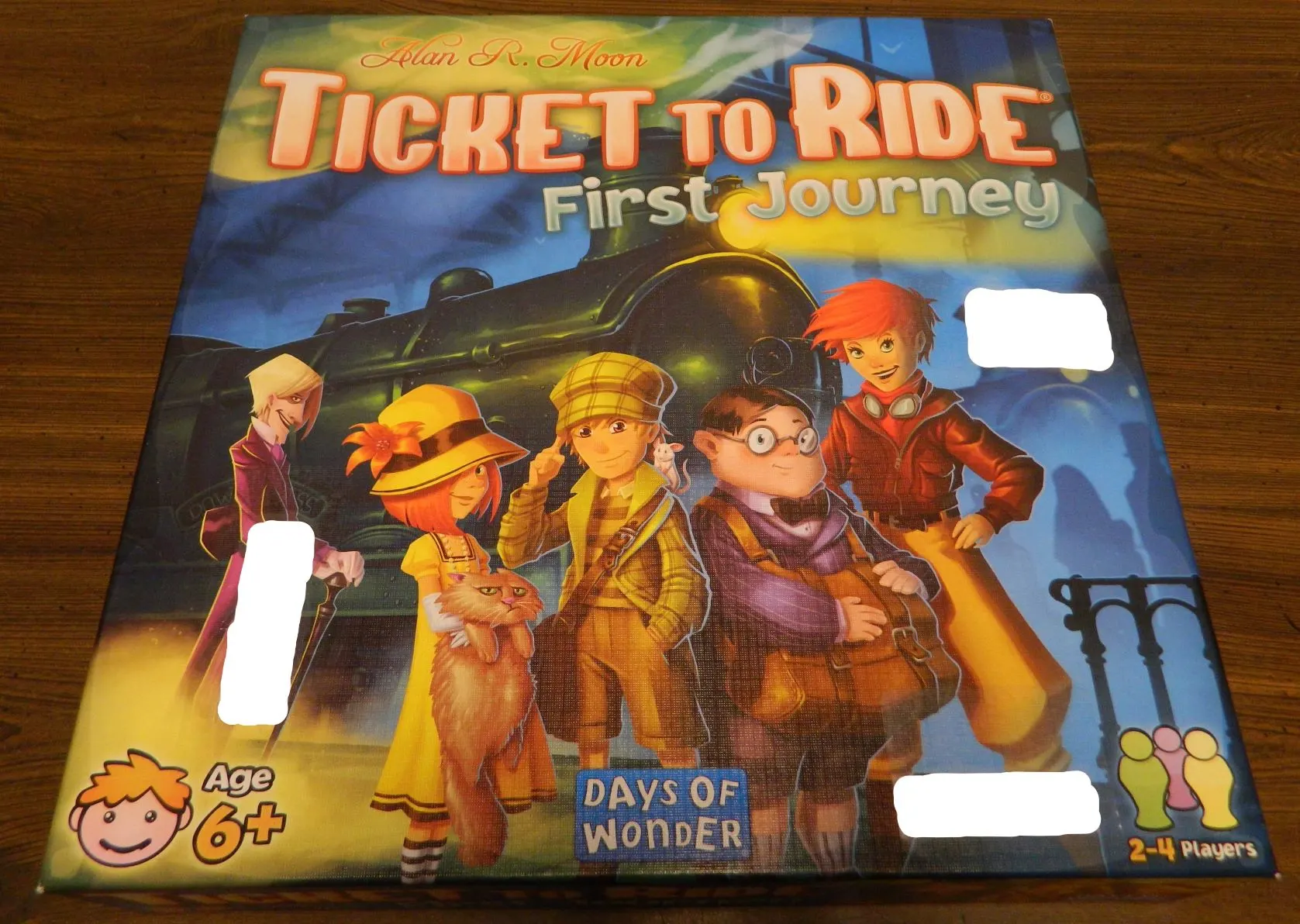
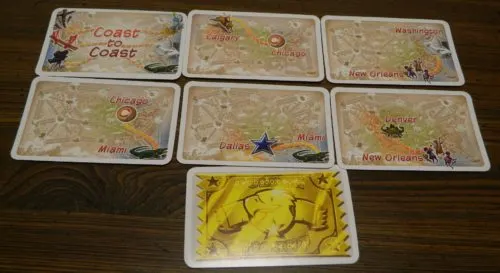
Mike D
Tuesday 10th of August 2021
Hi, Can a player complete a ticket, take a new ticket from the pile, and if they already have the routes completed for the new ticket, complete it, take a new ticket from the pile, and if they have the routes completed for it, complete it, etc ... all in one turn? Or, if you complete the tickets that are in your hand and draw new ones, must you wait until the next turn to complete those, even if you have the routes already completed? Thanks!
Eric Mortensen
Wednesday 11th of August 2021
I have to give credit to Board Game Geek for the answer I am about to give as there was a discussion about this exact question. The designer of the game, Alan Moon, responded to the question as well so that is probably as close as you can get to the official answer.
Based on Alan Moon's response in your scenario you will be able to keep completing tickets and drawing new ones if you already have the routes to complete them. Thus you could complete multiple tickets on the same turn.